Arm Announces Neoverse V1, N2 Platforms & CPUs, CMN-700 Mesh: More Performance, More Cores, More Flexibility
by Andrei Frumusanu on April 27, 2021 9:00 AM EST- Posted in
- CPUs
- Arm
- Servers
- Infrastructure
- Neoverse N1
- Neoverse V1
- Neoverse N2
- CMN-700
PPA & ISO Performance Projections
We’ve noted about the microarchitectural changes in the new V1 and N2 processors, as well as their IPC improvements, but it’s important to actually put things into context of the actual performance and power requirements to reach those figures. Arm presented an ISO-process node figures of what we can expect out of the designs:
Starting off, we’re presented with a refresher of where exactly the Neoverse N1 was projected to end up. Back in 2019, the company had noted that an N1 core with 1MB L2 would take roughly 1.4mm² of area, and use up to 1.8W at 3.1GHz (TSMC 7nm node projection).
We’ve generally seen more conservative implementations (Graviton2) and more aggressive implementations (Altra Q) of the N1, but Arm states that their original presilicon projections ended up within 10% of the actual silicon performance figures of the respective products.
Compared to an N1, the V1 is meant to achieve 50% higher IPC, or 1.5x its predecessor while maintaining the same frequency capabilities.
What’s important to note on the slide here is that Arm is stating that power efficiency ranges from 0.7x to 1x that of the N1. Reversing the calculation for power usage increases, we actually end up with a 1.5x to 2.14x increase, which is actually quite significant. Arm also notes that the core is 1.7x larger than the N1, which is also a significant figure.
SiPearl’s Rhea chip was the first publicly known Neoverse V1 design and it features 72 cores on a N6 process node. The V1 core’s vastly increased power consumption means that it’s going to be incredibly hard to achieve similar clock frequencies while remaining in the similar 250W TDP range such as that of a current-gen top-end 80-core Altra chip, so either the core will have higher TDPs, or running at lower frequencies.
Arm also projects further non-ISO process performance figures which we’ll cover just a bit later, but there the company showcases a reference design of the V1 with 96 cores on 5nm at 2.7GHz. This means that whilst the microarchitecture seemingly would have the same frequency capabilities, the much higher power consumption of the core puts a practical limit onto the maximum frequency of any such larger core count designs.
The Neoverse N2 seems a more appropriate design. Only losing out 10% IPC versus the V1, its power consumption is targeted to be only 1.45x higher than that of an N1, meaning efficiency lands in at an almost equal 96%. The area usage here is also only 1.3x that of an N1.
So generally speaking, the N2 seems to be a linear increase in performance over the N1 – both in performance and power. While this is not a regression in efficiency (well a small one at least), it does actually mean that in terms of frequency and end-performance targets, new N2 designs require larger generational process node improvements for actual vendors to be able to actually achieve the larger IPC and performance improvements that the new microarchitectures are promising.
I take note again of situations and workloads on the Ampere Altra where we’ve seen that there’s lots of workloads where the chip operates at below the TDP because the CPUs are underutilised. If an N2 design would be able to raise performance in such workloads, and more heavily throttle itself in higher demanding high utilisation workloads, it would still mean a net positive performance benefit even regardless of process node progresses. It’s a balance and situation that will be interesting to see how it plays out in eventual Neoverse N2 products.
In terms of absolute IPC improvements, Arm also disclosed a more varied set of workloads and what to expect out of the V1 and N2.
For the V1, the IPC improvements are roughly 50% median, with SPEC CPU essentially ending up at this figure. Arm made emphasis that there’s a set of workloads that are able to take advantage of SVE and the increased vector execution width of the V1 microarchitecture to achieve IPC improvements in excess of 100-125%, which is quite impressive.
The N2’s median IPC increase lands at a median of 32%, with SPEC CPU at roughly those marketed 40% figure. The high-end isn’t as high as that of the V1, but still in excess of +50% IPC.
Finally, Arm also posted estimated figures for the components of SPEC CPU 2017, where we see the generational improvements be relatively even across the workloads, with a few exceptions where the V1’s larger characteristics come into play. There’s also workloads such as 541.leela_r where the N2 actually leads the V1, and Arm explained this by the fact that the N2 is actually a newer microarchitecture with further front-end improvements that aren’t found on the V1.


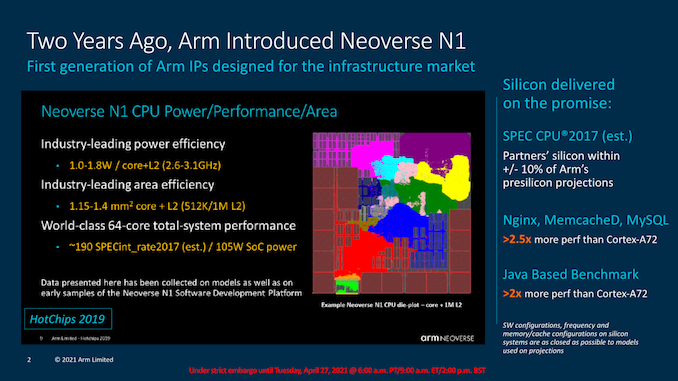
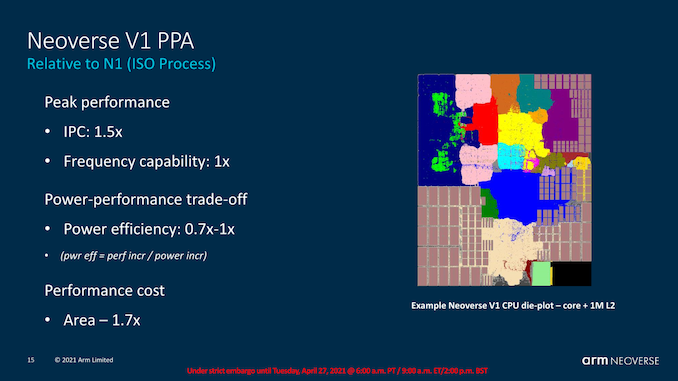
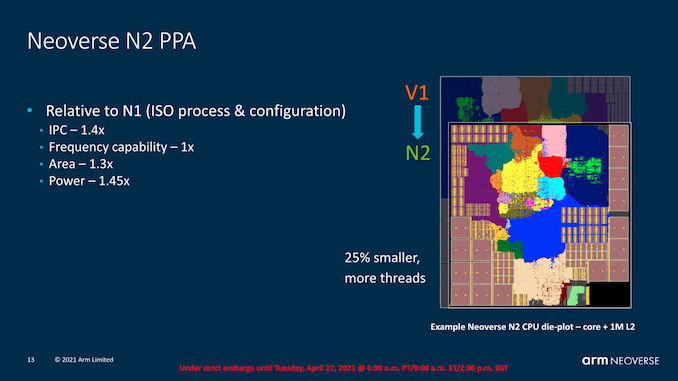
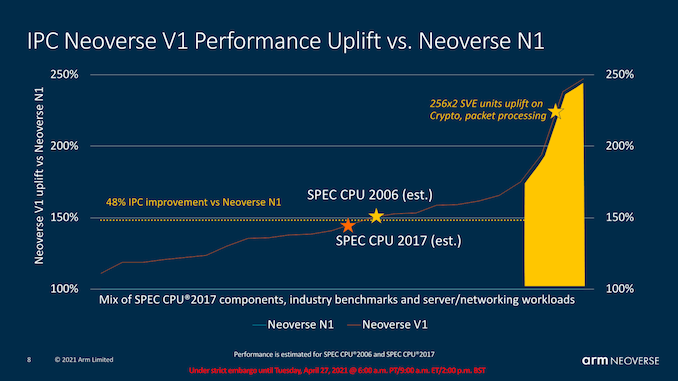
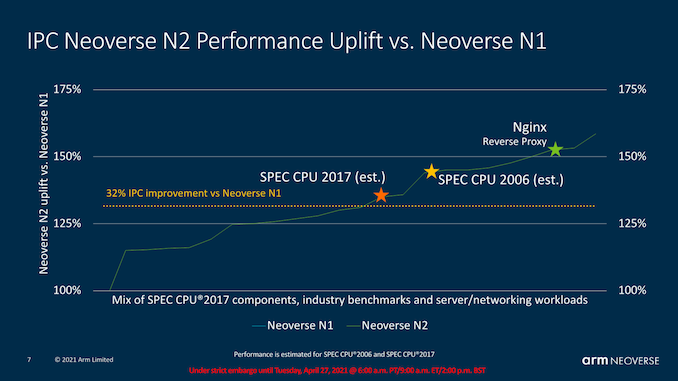
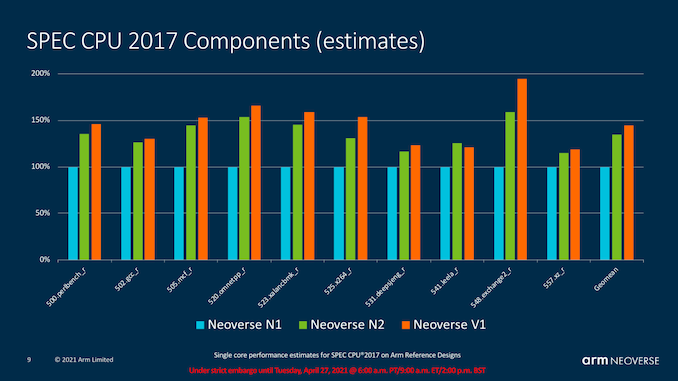








95 Comments
View All Comments
GeoffreyA - Friday, April 30, 2021 - link
"This is in comparison to x86 which seems to live in (probably justified) terror that any change they make, no matter how low level"P6, Netburst, Sandy Bridge, and Bulldozer seem like pretty big changes.
name99 - Friday, April 30, 2021 - link
(a) Sandy Bridge was the last such.(b) Look at the relative spacing (in time) for the two cases.
Look, I'm not interested in "x86 vs ARM. FIGHT!!!"
I'm simply pointing out various patterns I've noted that strike me as interesting and significant. If other people have similar such patterns to point out -- interesting and non-obvious aspects of new x86 micro-architectures, or patterns in how those micro-architectures have evolved over the past few years, they should add a comment.
But to this outsider the micro-architectures look stagnant -- utterly so in the case of Intel, mostly so in the case of AMD. In particular slight scaling up of an existing micro-architectures because a new process is more dense is not interesting! What is interesting is a new way of conceptualizing the problem that allows for a step change in the micro-architecture; and that is what I am not seeing on the x86 side.
I do see it in IBM (though for purposes that are, to me, uninteresting, both for POWER and for z/)
I do see it in ARM Ltd.
mode_13h - Friday, April 30, 2021 - link
> What is interesting is a new way of conceptualizing the problem that allows for a step change in the micro-architectureYes, but I think that largely depends on the ISA. And there, ARM has indeed been rather stagnant. Besides SVE and their new security features, most of their ISA changes have been tweaking around the margins. Not a fundamental rethink, or anything close to it.
What we need is more willingness to rethink the SW/HW divide and look at what more software can do to make hardware more efficient. Whenever I say this, people immediately seem to think I mean doing a VLIW-like approach, but that's too extreme for most workloads. You just have to look at an energy breakdown of a modern CPU and think creatively about where compilers could make the hardware's job a little bit easier or simpler, for the same or better result.
You can also flip it around, and ask where the primitives CPUs provide don't quite match up with what software is trying to do. I think TSX/HLE stands as an interesting example of that, and probably one where Intel doesn't get enough credit (granted, partly due to their own missteps).
name99 - Friday, April 30, 2021 - link
Architecture and micro-architecture are two different things.You want to fantasize about different architectures, be my guest. But I'm interested in MICRO-ARCHITECTURE and that was the content of my comments.
mode_13h - Saturday, May 1, 2021 - link
> Architecture and micro-architecture are two different things.The principle manifestation of the HW/SW divide is the ISA. That's why I talk about it rather than "architecture", which is a word that can mean different things to different people and in different contexts.
> You want to fantasize about different architectures, be my guest.
It's about as on-topic here as ever, given that we've gotten our most detailed look at ARMv9, yet. And performance + efficiency numbers!
> But I'm interested in MICRO-ARCHITECTURE and that was the content of my comments.
There's only so much you can do, within the constraints of an ISA. ARM had a chance to think really big, but they chose to play it safe and be very incremental. That could turn out to be a very costly mistake, for them and some of their licensees.
I just want what I think we all want, which is another decade of progress in performance and efficiency like the last one. So far, I'm not very hopeful. I guess we need to really hit the wall, before people are ready to get serious about embracing options to push it back, a bit further.